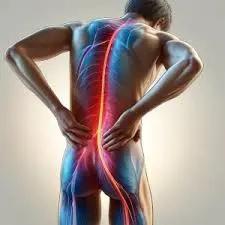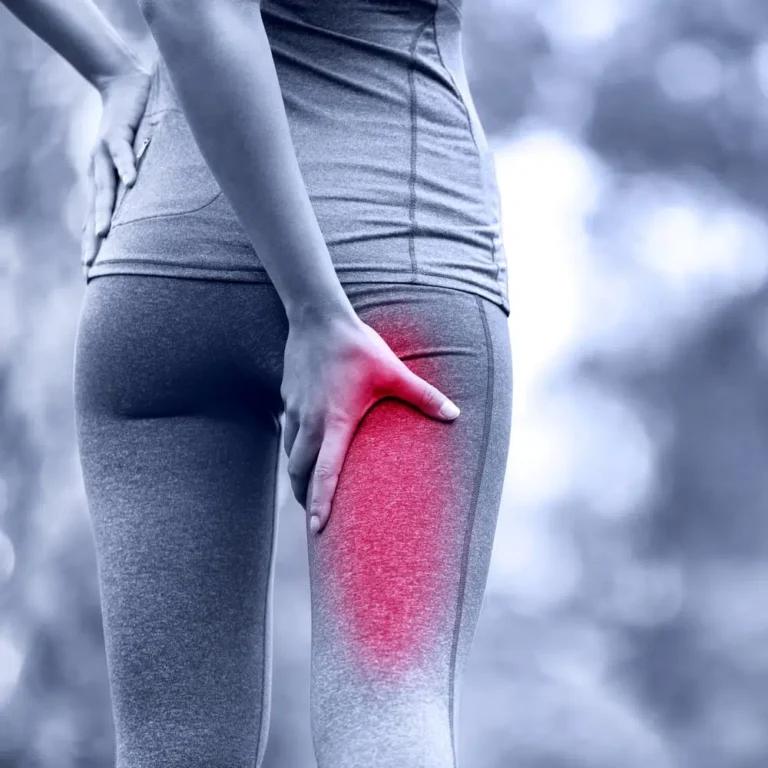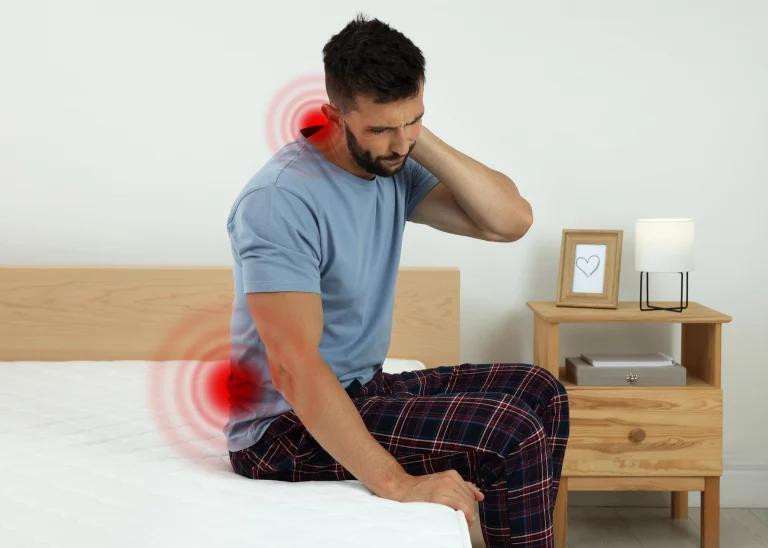Sciatica also known as lumbar radiculopathy is a condition that can cause severe lower back pain, tingling, and numbness which may travel down through the legs. In this guide, we’ll explore the causes of sciatica, the symptoms, and treatments – from self-care measures to surgical interventions.
Understanding sciatica
Sciatica is used to describe the symptoms that arise when the sciatic nerve, the longest and thickest nerve in the body, becomes irritated or compressed. This nerve bundle originates in the lower back and extends down through the hips, buttocks, and legs, branching out to the feet.
The most common causes of sciatica include:
- Bulging or herniated disk: When the discs between the vertebrae in the spine become damaged or move, they can put pressure on the surrounding nerves, leading to sciatic nerve pain
- Spinal stenosis: Narrowing of the spinal canal, which can compress the nerves and cause sciatica
- Degenerative disc disease: As the discs in the spine break down with age, they can lose their cushioning ability, causing the vertebrae to rub against each other, irritating the sciatic nerve
- Piriformis syndrome: The piriformis muscle in the buttocks, can sometimes spasm and put pressure on the sciatic nerve, triggering sciatica
- Pregnancy: The growing fetus can put pressure on the sciatic nerve
The classic symptoms of sciatica include:
- Pain: Mild to severe pain typically described as a sharp, burning, or electric shock-like sensation that radiates from the lower back in the lumbar spine down through the buttocks, leg, and sometimes even into the foot
- Numbness or tingling: A pins-and-needles sensation or complete loss of feeling in the affected leg, foot, or toes
- Muscle weakness: The inability to move or control the muscles in the leg or foot due to nerve damage
- Bowel or bladder problems: In severe cases, sciatica can cause a loss of bowel or bladder control
Seek medical attention if you experience any of these symptoms, as they may indicate a more serious underlying condition that requires prompt treatment.
Diagnosing sciatica
To diagnose sciatica, healthcare professionals will typically begin with a thorough physical examination. They may ask you to perform various movements, such as walking on your toes or heels, rising from a squatting position, or lifting your legs one at a time while lying on your back. These tests can help pinpoint the source of the nerve irritation.
In addition to the physical exam, your healthcare provider may order one or more diagnostic tests:
- X-rays: These can reveal any structural changes in the spine, such as bone spurs or disc degeneration
- Magnetic Resonance Imaging (MRI): An MRI scan provides detailed images of the soft tissues in the back, which will help to identify any herniated or bulging discs, as well as any other potential causes of nerve compression
- Computed Tomography (CT) Scan: A CT scan can help visualise the bones and structures in the spine, aiding in the diagnosis of spinal stenosis or other abnormalities
- Electromyography (EMG): This test measures the electrical activity in the muscles, which can help determine the severity of the nerve damage and identify specific nerve roots affected
Combining the physical examination with these tests can help develop an understanding of your condition to create a treatment plan for your specific needs.
Self-care for sciatica relief
For many individuals, sciatica can be managed effectively through a combination of self-care measures and treatments, such as:
Stay active
Long periods of inactivity can worsen your sciatica pain. Try to maintain your normal daily activities as much as possible. Gentle exercises, such as walking, swimming, or low-impact aerobics, can help improve blood flow, reduce inflammation, and promote healing.
Apply heat and cold therapy
Alternating between heat and cold can be an effective way to manage sciatica pain. Start with cold therapy, using ice packs or frozen gel packs on the affected area for 20 minutes at a time, several times a day. After the first few days, switch to heat, using a heating pad or warm compress, to help relax the muscles and improve circulation.
Stretch and strengthen
Strengthening and stretching exercises can help reduce pressure on the sciatic nerve. Work with a physical therapist or other healthcare provider to develop an exercise program that targets the muscles and joints involved in your sciatica. Exercises focusing on the lower back, hips, and core can be particularly beneficial.
Over-the-counter medications
Non-steroidal anti-inflammatory drugs (NSAIDs), such as ibuprofen or naproxen, can help reduce inflammation and reduce pain. Follow the instructions on the medication label and speak to your healthcare provider if the pain continues or worsens.
Alternative therapies
Complementary treatments, such as acupuncture, chiropractic adjustments, and massage therapy, may provide relief from sciatica. These can be a valuable addition to a comprehensive treatment plan.
Treatment for sciatica
If self-care measures do not provide sufficient relief, you may be recommended more advanced conservative treatments to address your sciatica symptoms.
Prescription medications
Your healthcare provider may prescribe stronger sciatica pain relief medications, such as muscle relaxants, antidepressants, or anti-seizure drugs, to help manage the neuropathic (nerve-related) pain associated with sciatica.
Physical therapy
A physical therapist can create a personalised treatment plan that may include exercises, such as stretches and manual therapy techniques, as well as ultrasound or electrical stimulation to reduce pain and improve mobility.
Spinal injections
Epidural steroid injections, administered directly into the space around the spinal cord, can help reduce inflammation and provide temporary relief from sciatica symptoms.
Alternative therapies
Other complementary treatments such as yoga, massage therapy, and acupuncture, may be incorporated into a comprehensive treatment plan under the guidance of your healthcare provider.
These treatments reduce inflammation, improve mobility, and address the underlying cause of your sciatica, while helping you manage your pain and maintain your quality of life.
Surgical interventions for severe sciatica
When conservative treatments fail to provide relief or if there are signs of nerve damage, your healthcare provider may recommend surgical intervention.
Discectomy
This involves the removal of a portion of a herniated or bulging disc that is putting pressure on the sciatic nerve. By removing the disc material, the pressure on the nerve is relieved, and pain is reduced.
Laminectomy
A laminectomy is the removal of a small section of the vertebral bone to create more space for the nerves and alleviate compression.
Spinal fusion
In cases of severe spinal instability, spinal fusion surgery may be performed to provide stability and reduce nerve irritation.
Surgery should only be considered after other treatments have been exhausted and when the potential benefits outweigh the risks. Your healthcare provider will evaluate your case and discuss the most appropriate surgical option, if any, for your needs.
Preventing recurrent sciatica
It’s essential to take steps to prevent the condition from recurring. Here are some strategies that can help:
Maintain good posture
Be mindful of your posture, whether you’re sitting, standing, or engaging in physical activities. Proper alignment of your spine can help reduce the strain on your back and lower the risk of nerve compression.
Strengthen your core
Building up the muscles in your core, including your abdominal and back muscles, can provide better support for your spine and help prevent future episodes of sciatica.
Lose weight
Achieving and maintaining a healthy weight can significantly reduce your chances of experiencing recurrent sciatica.
Quit smoking
Smoking can impair blood flow and increase the risk of disc degeneration, contributing to the development of sciatica. Quitting smoking may help improve your overall spinal health.
Practice safe lifting techniques
Use proper form when lifting heavy objects. Keep your back straight, and avoid twisting or bending at the waist to help prevent sudden injuries that may lead to sciatica.
You can reduce the likelihood of a recurrence of sciatica and maintain a healthier, more active lifestyle, by incorporating these preventive measures into your daily routine
Recovery from sciatica
Here are some additional considerations to keep in mind as you work towards recovery:
Patience and persistence
Healing from sciatica can take time, be patient with yourself. Stick to your treatment plan, and don’t get discouraged if progress seems slow. Consistent effort and a positive mindset can go a long way in your recovery.
Speak to your healthcare provider
Keep your healthcare provider informed about your progress, about changes in your symptoms, and any concerns you may have. They can adjust your treatment plan and guide you to ensure you’re on the right track.
Seek support
Reach out to family, friends, or support groups for emotional and practical assistance during your recovery. Sharing your challenges with others who understand can be incredibly valuable.
Manage stress and anxiety
Incorporate stress-reduction techniques, such as meditation, deep breathing, or counselling, into your recovery plan to help manage the psychological aspects of sciatica.
Conclusion
Sciatica can be a debilitating condition, but with the right approach, it can be overcome. By understanding the causes, recognising the symptoms, and exploring the treatment options available, you can take control of your sciatica.
Sources
- Sciatica – Diagnosis and treatment – Mayo Clinic
- Sciatica: What It Is, Causes, Symptoms, Treatment & Pain Relief
- Sciatica – NHS
Medical Disclaimer
NowPatient has taken all reasonable steps to ensure that all material is factually accurate, complete, and current. However, the knowledge and experience of a qualified healthcare professional should always be sought after instead of using the information on this page. Before taking any drug, you should always speak to your doctor or another qualified healthcare provider.
The information provided here about medications is subject to change and is not meant to include all uses, precautions, warnings, directions, drug interactions, allergic reactions, or negative effects. The absence of warnings or other information for a particular medication does not imply that the medication or medication combination is appropriate for all patients or for all possible purposes.








